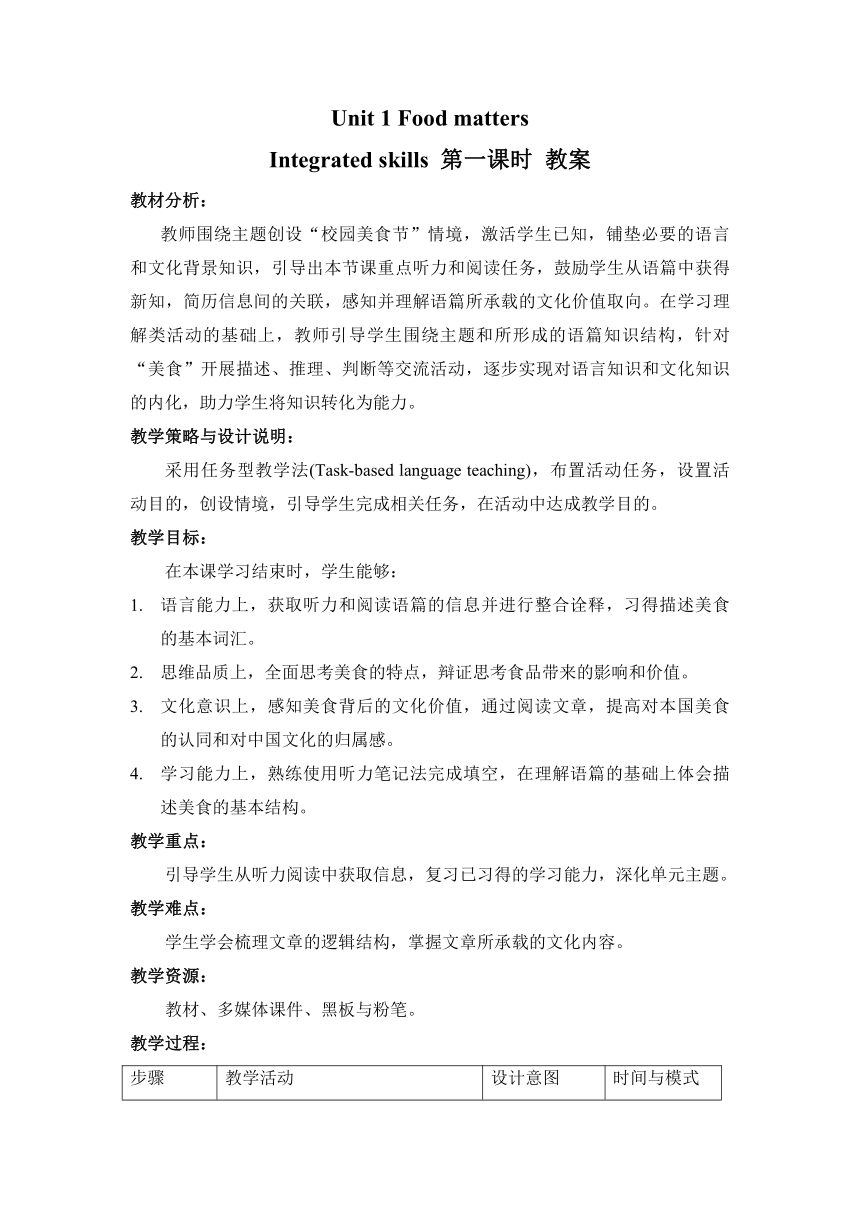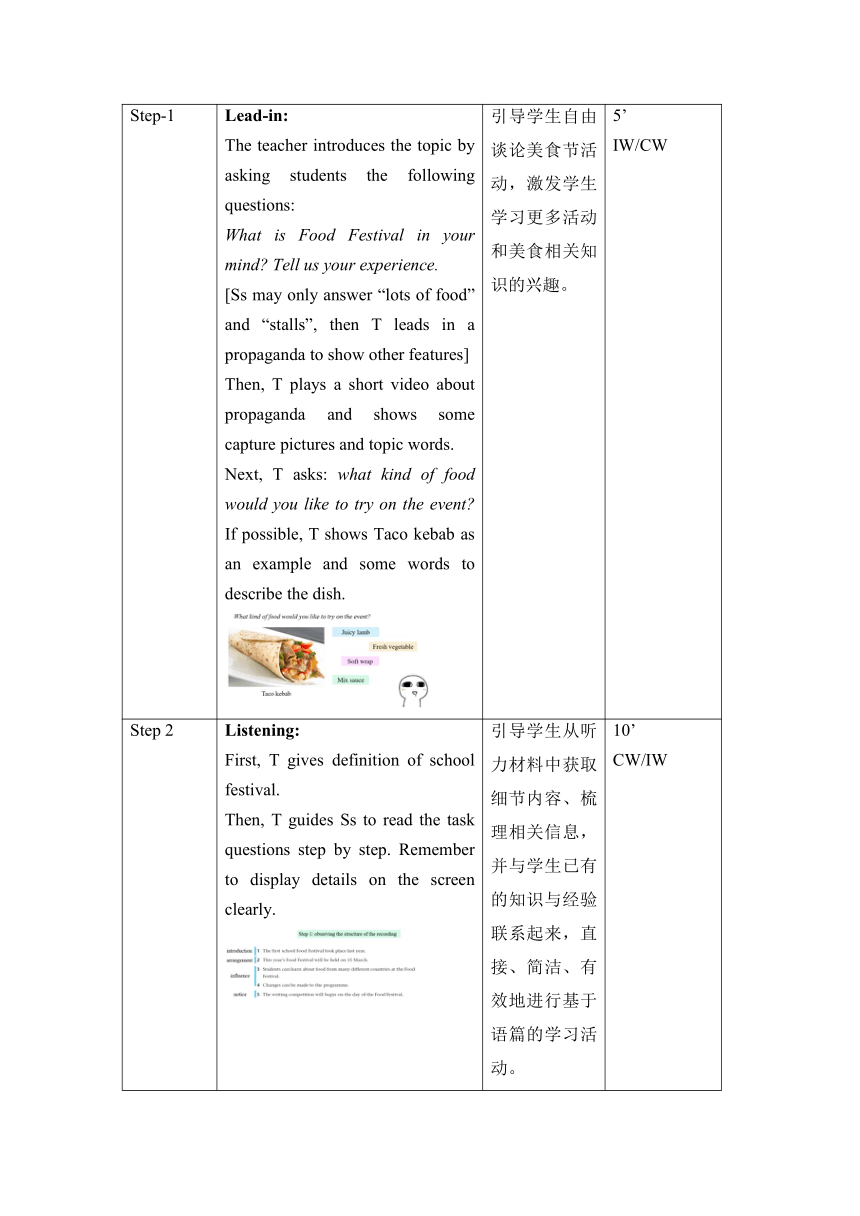译林版(2019) 选择性必修第一册Unit 1 Food Matters Integrated skills 第一课时 教案(表格式)
文档属性
| 名称 | 译林版(2019) 选择性必修第一册Unit 1 Food Matters Integrated skills 第一课时 教案(表格式) |  | |
| 格式 | docx | ||
| 文件大小 | 557.1KB | ||
| 资源类型 | 教案 | ||
| 版本资源 | 牛津译林版(2019) | ||
| 科目 | 英语 | ||
| 更新时间 | 2024-04-04 21:55:27 | ||
图片预览


文档简介
Unit 1 Food matters
Integrated skills 第一课时 教案
教材分析:
教师围绕主题创设“校园美食节”情境,激活学生已知,铺垫必要的语言和文化背景知识,引导出本节课重点听力和阅读任务,鼓励学生从语篇中获得新知,简历信息间的关联,感知并理解语篇所承载的文化价值取向。在学习理解类活动的基础上,教师引导学生围绕主题和所形成的语篇知识结构,针对“美食”开展描述、推理、判断等交流活动,逐步实现对语言知识和文化知识的内化,助力学生将知识转化为能力。
教学策略与设计说明:
采用任务型教学法(Task-based language teaching),布置活动任务,设置活动目的,创设情境,引导学生完成相关任务,在活动中达成教学目的。
教学目标:
在本课学习结束时,学生能够:
语言能力上,获取听力和阅读语篇的信息并进行整合诠释,习得描述美食的基本词汇。
思维品质上,全面思考美食的特点,辩证思考食品带来的影响和价值。
文化意识上,感知美食背后的文化价值,通过阅读文章,提高对本国美食的认同和对中国文化的归属感。
学习能力上,熟练使用听力笔记法完成填空,在理解语篇的基础上体会描述美食的基本结构。
教学重点:
引导学生从听力阅读中获取信息,复习已习得的学习能力,深化单元主题。
教学难点:
学生学会梳理文章的逻辑结构,掌握文章所承载的文化内容。
教学资源:
教材、多媒体课件、黑板与粉笔。
教学过程:
步骤 教学活动 设计意图 时间与模式
Step-1 Lead-in: The teacher introduces the topic by asking students the following questions: What is Food Festival in your mind Tell us your experience. [Ss may only answer “lots of food” and “stalls”, then T leads in a propaganda to show other features] Then, T plays a short video about propaganda and shows some capture pictures and topic words. Next, T asks: what kind of food would you like to try on the event If possible, T shows Taco kebab as an example and some words to describe the dish. 引导学生自由谈论美食节活动,激发学生学习更多活动和美食相关知识的兴趣。 5’ IW/CW
Step 2 Listening: First, T gives definition of school festival. Then, T guides Ss to read the task questions step by step. Remember to display details on the screen clearly. Next, while checking the answers, T needs to analyse the material sentence by sentence and highlight key words and complex sentences. 引导学生从听力材料中获取细节内容、梳理相关信息,并与学生已有的知识与经验联系起来,直接、简洁、有效地进行基于语篇的学习活动。 10’ CW/IW
Step 3 Discussion: T asks questions: What is the purpose of the school Food Festival Does it attract you And why [for concluding the main idea of material, and leading in the following detailed listening] 提出问题,总结材料主旨,联系学生自身经验,引出接下来的细节听力任务。 3’ CW
Step 4 Listening: T guides Ss to read the task questions step by step. Remember to display details on the screen clearly. 提高学生听力学习能力,熟练运用听力答题流程,提高学生捕捉信息的语言能力。 8’ CW
Step 5 Discussion T ask questions for summarizing the main activities on the festival and leading in the writing competition. If you were a student in the school, which activities would you go first And why [if nobody picks writing competition, T needs to guide Ss to think the attraction of the activity] If you need to write an article, what is your favourite food for writing And how can you describe it [leading in the two dishes in the following article and making Ss to think what should be described for the dish] 通过问答环节,总结听力中主要活动,学生联系自身,回答自己的喜好并引发对写作比赛的兴趣,初步形成如何描述食物的概念。 5’ IW/CW
Step 6 Reading: After reading the two passages, Ss need to take notes about the description of food. Then, T analyze the structure of article to give an impression of writing structure which is useful for next writing and speaking task. After the mooncake passage, T gives some question to arouse their love for our country and their deep memories in their childhood. Do you have any memories about mooncake Why is it meaningful for Chinese people After tiramisu passage, T can display a short video, and asks whether Ss are interested in tiramisu. If no, what’s their favourite dessert 帮助学生提炼信息,进一步探究主题意义、剖析文章结构、发展学生的创造性思维。 指导学生在实践、讨论、合作和探究中学会用英语表达和交流,发展其综合语言运用能力。 15’ GW/CW
Step 7 Homework: Think about a dish you really like, take some notes about it (background info, appearance, taste, memories…) and collect pictures if possible. 让学生寻找感兴趣的文章,并操练提取信息能力。 2’ IW/CW
备注:
Ss: Students T: Teacher
IW: Individual work GW: Group work CW: Class work
教学反思:
通过本课时学习,学生能否理解校园美食节的活动安排;
通过本课时学习,学生能否掌握提高听力笔记能力和掌握语篇结构能力;
通过本课时学习,学生能够提高对中国美食文化的认同并产生情感共鸣。
Integrated skills 第一课时 教案
教材分析:
教师围绕主题创设“校园美食节”情境,激活学生已知,铺垫必要的语言和文化背景知识,引导出本节课重点听力和阅读任务,鼓励学生从语篇中获得新知,简历信息间的关联,感知并理解语篇所承载的文化价值取向。在学习理解类活动的基础上,教师引导学生围绕主题和所形成的语篇知识结构,针对“美食”开展描述、推理、判断等交流活动,逐步实现对语言知识和文化知识的内化,助力学生将知识转化为能力。
教学策略与设计说明:
采用任务型教学法(Task-based language teaching),布置活动任务,设置活动目的,创设情境,引导学生完成相关任务,在活动中达成教学目的。
教学目标:
在本课学习结束时,学生能够:
语言能力上,获取听力和阅读语篇的信息并进行整合诠释,习得描述美食的基本词汇。
思维品质上,全面思考美食的特点,辩证思考食品带来的影响和价值。
文化意识上,感知美食背后的文化价值,通过阅读文章,提高对本国美食的认同和对中国文化的归属感。
学习能力上,熟练使用听力笔记法完成填空,在理解语篇的基础上体会描述美食的基本结构。
教学重点:
引导学生从听力阅读中获取信息,复习已习得的学习能力,深化单元主题。
教学难点:
学生学会梳理文章的逻辑结构,掌握文章所承载的文化内容。
教学资源:
教材、多媒体课件、黑板与粉笔。
教学过程:
步骤 教学活动 设计意图 时间与模式
Step-1 Lead-in: The teacher introduces the topic by asking students the following questions: What is Food Festival in your mind Tell us your experience. [Ss may only answer “lots of food” and “stalls”, then T leads in a propaganda to show other features] Then, T plays a short video about propaganda and shows some capture pictures and topic words. Next, T asks: what kind of food would you like to try on the event If possible, T shows Taco kebab as an example and some words to describe the dish. 引导学生自由谈论美食节活动,激发学生学习更多活动和美食相关知识的兴趣。 5’ IW/CW
Step 2 Listening: First, T gives definition of school festival. Then, T guides Ss to read the task questions step by step. Remember to display details on the screen clearly. Next, while checking the answers, T needs to analyse the material sentence by sentence and highlight key words and complex sentences. 引导学生从听力材料中获取细节内容、梳理相关信息,并与学生已有的知识与经验联系起来,直接、简洁、有效地进行基于语篇的学习活动。 10’ CW/IW
Step 3 Discussion: T asks questions: What is the purpose of the school Food Festival Does it attract you And why [for concluding the main idea of material, and leading in the following detailed listening] 提出问题,总结材料主旨,联系学生自身经验,引出接下来的细节听力任务。 3’ CW
Step 4 Listening: T guides Ss to read the task questions step by step. Remember to display details on the screen clearly. 提高学生听力学习能力,熟练运用听力答题流程,提高学生捕捉信息的语言能力。 8’ CW
Step 5 Discussion T ask questions for summarizing the main activities on the festival and leading in the writing competition. If you were a student in the school, which activities would you go first And why [if nobody picks writing competition, T needs to guide Ss to think the attraction of the activity] If you need to write an article, what is your favourite food for writing And how can you describe it [leading in the two dishes in the following article and making Ss to think what should be described for the dish] 通过问答环节,总结听力中主要活动,学生联系自身,回答自己的喜好并引发对写作比赛的兴趣,初步形成如何描述食物的概念。 5’ IW/CW
Step 6 Reading: After reading the two passages, Ss need to take notes about the description of food. Then, T analyze the structure of article to give an impression of writing structure which is useful for next writing and speaking task. After the mooncake passage, T gives some question to arouse their love for our country and their deep memories in their childhood. Do you have any memories about mooncake Why is it meaningful for Chinese people After tiramisu passage, T can display a short video, and asks whether Ss are interested in tiramisu. If no, what’s their favourite dessert 帮助学生提炼信息,进一步探究主题意义、剖析文章结构、发展学生的创造性思维。 指导学生在实践、讨论、合作和探究中学会用英语表达和交流,发展其综合语言运用能力。 15’ GW/CW
Step 7 Homework: Think about a dish you really like, take some notes about it (background info, appearance, taste, memories…) and collect pictures if possible. 让学生寻找感兴趣的文章,并操练提取信息能力。 2’ IW/CW
备注:
Ss: Students T: Teacher
IW: Individual work GW: Group work CW: Class work
教学反思:
通过本课时学习,学生能否理解校园美食节的活动安排;
通过本课时学习,学生能否掌握提高听力笔记能力和掌握语篇结构能力;
通过本课时学习,学生能够提高对中国美食文化的认同并产生情感共鸣。
同课章节目录
- Unit 1 Food matters
- Welcome to the unit
- Reading
- Grammar and usage
- Integrated skills
- Extended reading
- Project
- Unit 2 The Universal Language
- Welcome to the unit
- Reading
- Grammar and usage
- Integrated skills
- Extended reading
- Project
- Unit 3 The art of painting
- Welcome to the unit
- Reading
- Grammar and usage
- Integrated skills
- Extended reading
- Project
- Unit 4 Exploring poetry
- Welcome to the unit
- Reading
- Grammar and usage
- Integrated skills
- Extended reading
- Project
